For questions ask Laurent Itti.
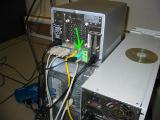 |
First, make sure your stimulus presentation computer is properly
setup, hooked up to keyboard and mouse, to the monitor, to the serial
communications towards the eye tracker, etc. |
 |
Help your subject find a comfortable position. It is usually a good
idea to start seating from the side, then rotate the chair to face the
computer screen. |
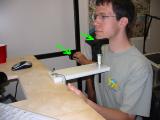 |
Avoid modifying the position and height of the chin-rest; instead,
use the electric up/down command switch to adjust the height of the
chair. Instruct your subject to play with the setting until a truly
comfortable position is achieved. |
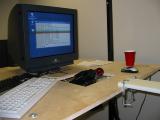 |
Meanwhile, get your stimulus presentation computer ready and your
stimulus program ready to start for that particular subject.
|
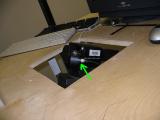 |
Also meanwhile, connect the infrared light source power cable to
the plug on the back of the light source. Don't forget to disconnect
it once your session is over! |
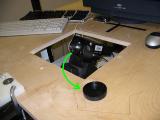 |
Remove the cap from the camera lens and check that everything is
clean. |
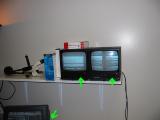 |
Power-on the monitors and check that you can see your subject's
face, your stimulus, and start the ISCAN Daq program. |
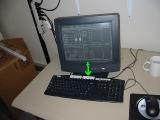 |
Use the pan/tilt controls and the zoom/focus/iris controls (on the
separate control box not shown here) to zero-in onto your subject's
right eye. CAUTION: make sure the camera does not hit the table as you
move it around, since the hole in the table is fairly small. Get some
ambient light using the halogen torchiere. |
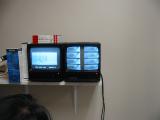 |
Once you have the eye well centered, ask your subject to start
holding still. Also ask your subject to quickly cycle through the four
corners of the screen to make sure the pupil will not get out of the
camera's field of view as the eye moves. |
 |
Adjust the orientation of the infrared light source to obtain the
clearest possible image of the eye on your control monitor.
|
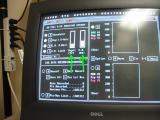 |
Press F7 to activate the pupil threshold, then the up and down
cursor keys to adjust it. Press F8 to activate the corneal reflection
threshold, then the up and down cursor keys to adjust it. See below
for what you should see on the control monitor once the thresholds are
correct. |
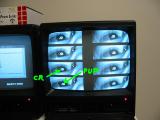 |
Play with the pupil threshold (F7 and up/down keys) until you have
a clean white disk on the pupil and a cross at its center. You don't
want too much junk outside the pupil. Play with the corneal reflection
threshold (F8 and up/down keys) until you have a cleanly segmented
specular reflection of the infrared light onto the subject's eye, and
a cross on it. It is okay if the corneal reflection overlaps with the
pupil.
|
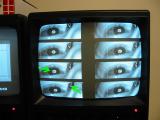 |
When adjusting the pupil threshold, try to minimize noise pixels
outside the pupil, yet try to find a threshold where the cross
reliably stays on the pupil (ask your subject to look at various
places and blink). Typically, it is okay to have a bit of noise on the
iris and eyelashes. Avoid the presence of other hot spots in the image
(e.g., here we have a couple on the subject's eyeglasses), as they may
be confounded for the pupil and/or corneal reflection. Play with zoom
and focus using the control box. |
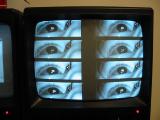 |
Once you are well zoomed, focused, centered, and thresholded, it
should look like that. The crosses should be robustly present even if
you move your threshold up/down a bit. |
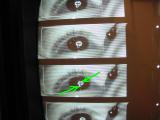 |
That's looking good to me! |
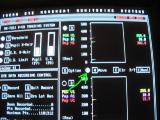 |
Switch the tracker to 'move' mode by pressing the M key. You should
start seeing some scrolling traces. |
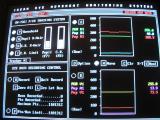 |
The scrolling traces for POR-H1 (point-of-regard, horizontal) and
POR-V1 (vertical) will be flat as the tracker is not yet
calibrated. The others should move when you subject makes eye
movements and blinks. |
 |
Now do the POR (point-of-regard) calibration; POR is computed from
the comparative pupil and corneal reflection measurements. To see the
POR you first need to calibrate the tracker (this is the Daq-based
calibration and is necessary to get POR data at all; you will then
typically also have a more sophisticated calibration procedure as part
of your stimuli once the Daq is all ready to go). Press the Option key
O several times until you see the 'P.O.R. Calibrator #1' screen. Press
R to reset. |
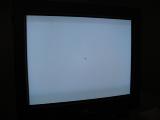 |
Start your stimulus program with a central fixation. |
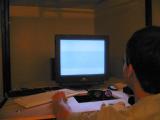 |
Make sure your subject is ready for action and knows where to press
keys (as needed by your paradigm) and already has the keyboard and
such properly positioned; otherwise your subject will move later on,
in order to try to find the keyboard or locate a key to press!
|
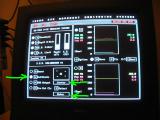 |
Press L to start the Daq calibration. The program shows you where
the subject should look (here, it's at the center). Tell your subject
to look there. While you look at the control monitor that shows you
the close-up of the eye, press RETURN to validate that position. It is
important to check the eye monitor WHILE you press RETURN so that you
will know whether the subject just blinked or moved as you acquired
the calibration point (in which case you will have to redo the
calibration). |
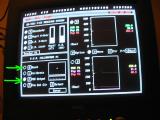 |
Once you have gone through all calibration points and pressed
RETURN to acquire each one, press R to reset, the P to activate the
point-of-regard output. The POR traces should now change as the
subject's eyes move. |
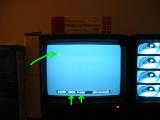 |
Also, once POR output is activated, the cross on the scene monitor
will follow the subject's point of regard. Ask your subject to look at
various places and check that the cross goes to those places. If the
calibration does not look too good, re-do it (R, then L, then RETURN
for each point, then R then P). Also the H and V numbers on the scene
monitor should vary as the cross moves around. |
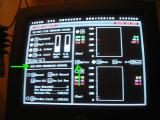 |
CAUTION: the eye tracker will not record unless you have the 'Eye
data recording control' window displayed; to get it, press O (option)
several times until you get it. Your tracker is now ready to start
recording either using manual trigger (R/Q keys, not recommended!) or
external serial-port trigger (that's what you want for clean
data). |
 |
Ask your subject to look at various things one more time, check
that you get reliable POR-H1 and POR-V1 traces, reliable crosses at
pupil and corneal reflection on the eye monitor, reliable cross
following the eye on the scene monitor, and get started with your
experiment! |
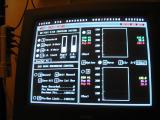 |
Once you are done, don't forget to save your data! Press M to stop
the move mode and the scrolling graphs. Now press 'ALT-F' to go to the
file menu and select 'save raw data'; go to the right folder (use TAB
and the cursor keys to highlight/select various things) and pick a
file name, then save the file. Do not save it in the default directory
(which is for eye tracker settings), rather go into the 'data'
subdirectory and then your own subdirectory. The 'data' subdirectory
is the one that also is available on the desktop. Quit the Daq program
and use SmartFTP to drag/drop your data file to an FTP server of your
choice. |
 |
Once you are ready to leave, DO NOT FORGET to disconnect the
infrared light source and turn off all three monitors (scene, eye and
eye-tracker computer), otherwise these will burn out and you will be
in big trouble! Also make sure to turn off all lights. Leave all
computers on, though. Put the cap back onto the camera lens to protect
it. Failure to handle this expensive and sensitive piece of equipment
properly will yield to exclusion from access to the eye-tracker
room. |

